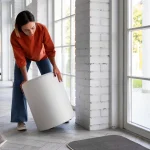
What you need to remember is where to place air purifier and what is the right location of your air purifier. That can mean the difference between merely having something that can work and actually enjoying sufficiently cleaner, better air. Not many people realize that strategic positioning is pretty much crucial to the overall effectiveness of the purifier, although the majority of people will focus their attention on branding or features.
Places where pollutants are likely to accumulate, like near windows, doors, and busy locations, are the places where an air purifier would be most effective in having a free airflow. The degree to which your unit is designed to trap any pollutants is linked to a variety of aspects, and among them is the size, design, and even position of the furniture.
Correct installation will ensure that your purifier is used to its full potential, allowing consistent and efficient air cleaning to take place in your house, whether you are trying to remove allergens in your bedroom or smell in your kitchen.
Where to Place Air Purifiers? —Why Placement Matters
An air purifier draws in dirty air, filters it, and releases clean air. If the unit is blocked, too close to walls, or hidden under furniture, its performance drops drastically. However, air purifier placement is essential to improving air circulation and coverage. Poor placement can:
- Reduce airflow
- Increase recirculation of dirty air
- Waste energy
- Minimize the device’s effectiveness in key areas
Ideal Locations for Air Purifier Placement
1. Near the Source of Pollution
Placing air purifiers near pollution sources is a primary strategy for fast, localized cleaning. If your main concern is wildfire smoke, cooking odors, or pet dander, place the unit close to where these pollutants originate.
Examples:
- Near the litter box or dog bed (for pet allergens)
- In the kitchen (for smoke and VOCs)
- Beside a window (if outside pollution is a concern)
2. Central Locations in Rooms
When you’re targeting general air quality improvement, center placement is key. This allows the device to pull air from all directions, ensuring balanced filtration.
- Avoid corners and tight spaces.
- Maintain at least 18–24 inches of clearance from walls.
3. Bedroom Air Purifier Placement
Bedrooms are where we spend most of our time sleeping, roughly 7–9 hours per night. To get the most out of your bedroom air purifier:
- Place it 6–10 feet from your bed.
- Keep it away from obstructions like curtains or nightstands.
- Ensure the clean air is directed toward your breathing zone.
Tip: Run it on low or sleep mode to maintain quiet operation overnight.
4. Office Air Purifier Placement
A clean office means better focus, productivity, and fewer sick days. For office air purifier usage:
- Position it near your desk, not under it.
- Avoid placing it right next to electronics or vents.
- Make sure it circulates air throughout the room and not just under your desk.
Bonus: Keep windows closed when the purifier is running for best results.
Technical Considerations for Placement for Where to Place Air Purifier?
1. Airflow Direction & Vents
Many purifiers draw air from the sides or bottom and push it out the top or front. Blocking these intakes or exhausts reduces effectiveness.
- Check the unit’s airflow design.
- Keep intake and output areas unobstructed.
2. Room Size vs. CADR Rating
Use an air purifier whose CADR (Clean Air Delivery Rate) matches the size of the room.
- For example, a room of 300 sq. ft. should use a purifier with a CADR of 200+.
- Placing the purifier in a small, enclosed area may increase effectiveness, but only if airflow is unrestricted.
3. Avoid Placing It on the Floor (Sometimes)
Unless the unit is designed to be floor-standing:
- Raise the purifier 2–4 feet off the ground to clean both upper and lower air layers.
- Use a table or shelf that allows for airflow below the unit.
4. Humidity & Heat Sources
Don’t place purifiers near humidifiers, heaters, or direct sunlight. Excess humidity or heat may damage internal components or alter filter performance.
Common Placement Mistakes to Avoid
- Tucking the purifier behind furniture
- Operating it in a completely closed-off space (like a closet)
- Running multiple units in the same room without proper spacing
- Blocking air intakes with walls or drapes
Maximizing coverage means letting the purifier do its job with optimal air exchange.
Advanced Placement Tips for Maximum Effectiveness
1. Use Multiple Units for Large Areas
Open-plan offices or living rooms over 500 sq. ft. often need more than one unit for full coverage.
- Place one unit near the main pollution source.
- Position the second unit in a central or opposite area for even distribution.
2. Consider Vertical Air Movement
Most allergens like dust and dander settle low, while warm air and VOCs rise. Strategic placement helps capture both.
- Use oscillating units that mix upper and lower air layers.
- Don’t rely only on ceiling fans or HVAC if air quality is poor.
3. Smart Placement with Air Quality Monitors
Advanced air purifiers include real-time AQI (Air Quality Index) sensors. Use these readings to adjust placement and fan speeds.
- Move the purifier near AQI hotspots for localized cleaning.
- Pair with smart home systems for automation based on pollution levels.
Go For Cleaner Air!
It is important to know where to place the air purifier and how to install it in the right position. The location of any air purifier is very important to the capacity of the air purifier to clean the air, either in an office or a bedroom.
Make use of open and central circulation areas. Understand the wind direction in your unit and avoid any hidden corners. Consider several devices or advanced monitors of air quality in locations of larger or more complex spaces. At BigWater, we not only help you choose the best air purifier but also help you feel free to use it properly. Find out about our lineup of high-efficiency purifiers and installation guide, and make your household truly hygienic and breathable.





